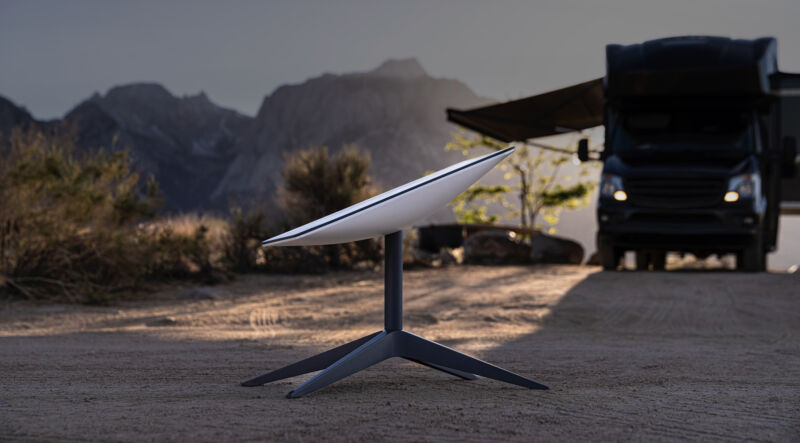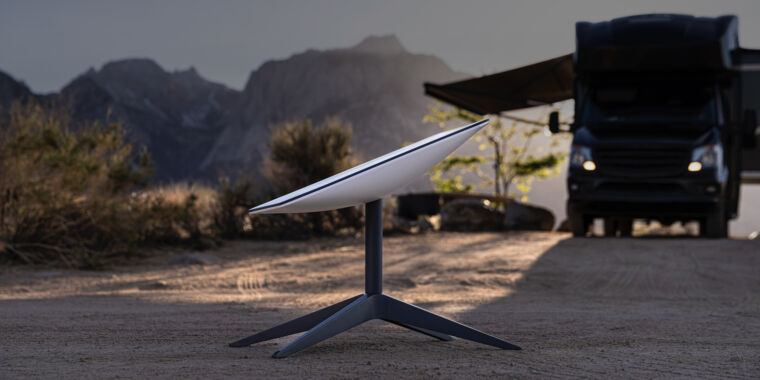
starlink
SpaceX has received US approval to provide Starlink satellite Internet service on moving vehicles, ships and aircraft. In an order released Thursday, the Federal Communications Commission granted SpaceX’s application to operate consumer and enterprise ground stations on the move (ESIM) across the US.
The FCC also approved a request from Kepler Communications to use ESIMs on ships. Starlink and Kepler may provide services on ships in US territorial and international waters.
Starlink offers a service for RVs, but says it’s not designed to be used while the vehicles are in motion. A version for moving RVs will presumably be offered at some point now that SpaceX has received FCC approval, which states, “SpaceX is authorized to use Earth Stations In Motion on vehicles in the United States.” SpaceX also plans to offer Starlink Internet on flights.
The order from the International Bureau of the FCC said granting the applications “will serve the public interest by enabling SpaceX and Kepler to offer expanded broadband capabilities and serve unserved and underserved areas.”
SpaceX asked the FCC for permission to offer Starlink broadband on moving vehicles, ships and aircraft in March 2021. SpaceX says it will use rugged Starlink dishes that can withstand “harsh environments” with extreme levels of heat and cold. The terminals are too big for passenger cars and intended for planes, ships, large trucks and RVs, SpaceX chief executive Elon Musk said last year.
FCC approves license after Dish . appeals
The spectrum bands used for space-to-Earth transmissions with ESIM range from 10.7 GHz to 12.7 GHz. The FCC is separately considering whether to allow cellular services in the 12.2-12.7 GHz band. Dish Network wants to use that band for its cellular network, but SpaceX argues that cellular service in 12 GHz would render Starlink useless for most Americans because the satellite Internet network uses the same spectrum for downloads.
The FCC injunction noted that Dish and RS Access objected to SpaceX and Kepler’s ESIM applications, arguing that approval “would effectively limit the Commission’s decision-making in the pending 12 GHz regulatory process” and “the ability of the Commission to use spectrum for terrestrial mobile.” But the FCC said the approval is constructed so as not to limit options for the 12 GHz process:
These services, which have never been available before, promise the potential to extend reach into remote and rural areas and enable higher quality broadband services in the air, road and water. However, we recognize that the introduction of a potentially significant number of additional end-users could impact the 12 GHz spectrum environment. We are therefore imposing conditions to ensure that the granting of this application does not materially affect the outcome of the 12 GHz regulatory process.
SpaceX must accept interference in the 12 GHz band
The FCC said the authorizations are “on a non-interference-protected, i.e, unprotected, basis related to operations in the 12.2-12.7 GHz band. Therefore, Applicants’ ESIM operations must accept any interference received from both current and future services authorized in the band – even if such interference causes undesired operations – and must not cause harmful interference to any authorized service, whether it is licensed or not.”
The FCC has required Starlink and Kepler “to disclose to their customers that their ESIM service is provided under these terms so that their customers understand that no protection against interference is expected. SpaceX and Kepler must review the unprotected status of their ESIM offerings.” on their websites, promotional literature and other consumer reporting resources, including retail locations, online platforms and telemarketing calls.”
If SpaceX and Kepler accept the licensing, they must do so “subject to the outcome of future regulations, including pending 12 GHz regulations,” which could lead to changes to bring the authorizations “in line with any rules or policies.” adopted by the Commission in the future,” the FCC said. In addition, end-user terminals that “can operate, e.greceived, in 12.2-12.7 GHz should also be capable of such operation in 10.7-12.2 GHz.”
We are trying to clarify SpaceX’s approval for the use of ESIMs in aircraft. The FCC order stated, “SpaceX is authorized to operate Earth Stations In Motion…on non-U.S.-registered aircraft operating in U.S. airspace,” but SpaceX also sought approval to provide service to “in the US registered aircraft operating worldwide”. We have reached out to the FCC for clarification and will update this article as we receive more information.
Update at 1:57 PM ET: An FCC spokesperson told Ars: “We are considering” [SpaceX’s] ESIMs awarded on US registered aircraft application.”

